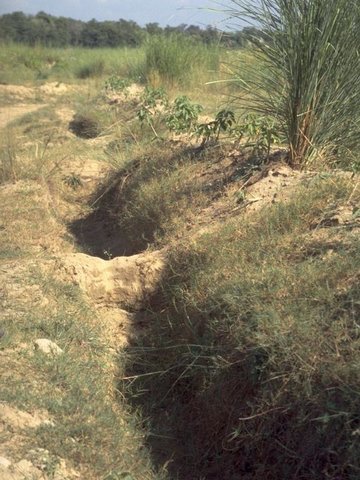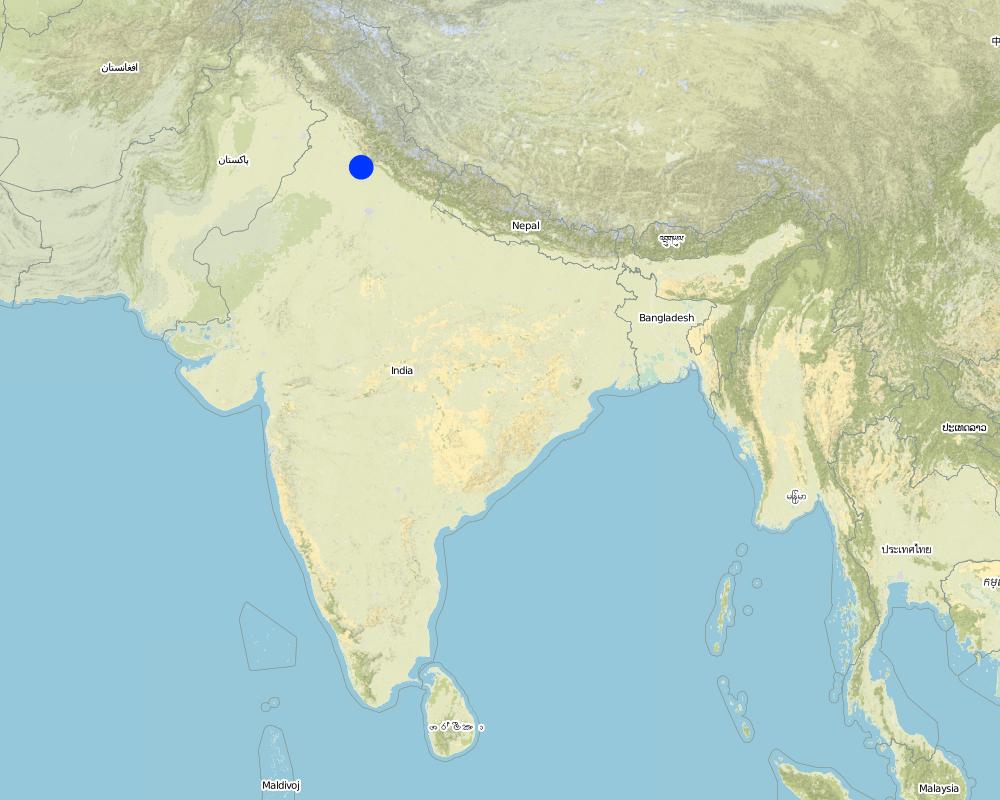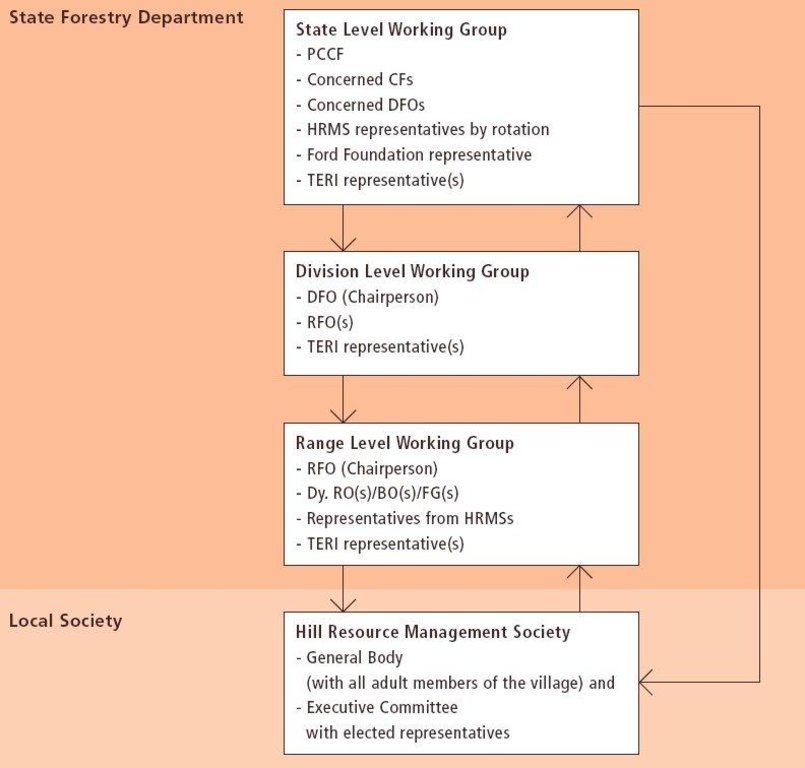Joint forest management [印度]
- 创建:
- 更新:
- 编制者: Sumana Datta
- 编辑者: –
- 审查者: Fabian Ottiger, Deborah Niggli
approaches_2370 - 印度
查看章节
全部展开 全部收起1. 一般信息
1.2 参与方法评估和文件编制的资源人员和机构的联系方式
SLM专业人员:
Varghese Paul
vpaul@teri.res.in
TERI, Habitat Place
Lodhi Road, New Delhi 110 003
印度
SLM专业人员:
Singh T.P.
11-91-4682111
TERI, Habitat Place
Lodhi Road, New Delhi 110 003, India
英属印度洋领地
SLM专业人员:
SLM专业人员:
Vashist Uma Shankar
11-91-4682111
TERI, Habitat Place
Lodhi Road, New Delhi 110 003
印度
有助于对方法进行记录/评估的项目名称(如相关)
Book project: where the land is greener - Case Studies and Analysis of Soil and Water Conservation Initiatives Worldwide (where the land is greener)有助于对方法进行记录/评估的机构名称(如相关)
Tata Energy Research Institute TERI (Tata Energy Research Institute TERI) - 印度1.3 关于使用通过WOCAT记录的数据的条件
编制者和关键资源人员接受有关使用通过WOCAT记录数据的条件。:
是
1.4 SLM技术问卷的参考

Forest catchment treatment [印度]
Catchment treatment of degraded forest land including social fencing, infiltration trenches and enrichment planting with trees and grasses for production and dam protection.
- 编制者: Chetan Kumar
2. SLM方法的描述
2.1 该方法的简要说明
Government and NGO supported community protection of forested catchments, through village-based Hill Resource Management Societies.
2.2 该方法的详细说明
该方法的详细说明:
Aims / objectives: Joint forest management (JFM) in India emerged in the 1980s from community initiatives in forest protection. At that time, less than half of the official forest land had good tree cover. Forest protection groups took action, based on 'social fencing' of degraded forest land. JFM was adopted by support agencies - NGOs and Government (State Forest Department) - when its full potential was realised. It is an approach that leads to environmental and production benefits through community co-operation in natural resource management. State-supported JFM in Haryana began on a pilot basis in Sukhomajri village in 1976, and has built on the success of that initiative, spreading to a total of nearly 200 km2, covering 60 villages in Ambala and Yamunagar Districts. The National Joint Forest Management Resolution of 1990 supported the rights of forest communities country-wide. In the same year, the Haryana State Government signed an agreement with The Energy and Resources Institute (formerly TERI: Tata Energy Research Institute) - underpinned by financial support from the Ford Foundation - to help establish Hill Resource Management Societies (HRMS). These state-sponsored, village level societies are key to the success of JFM, and their links to the State Forest Department are crucial.
Methods: The founding principles of HRMS include appropriate social composition, accountability and conflict resolution. They are open to all members of the village communities - regardless of gender or caste - who pay membership fees, and are then officially registered. Management committees are elected, and each must include at least two women. The HRMS oversee forest catchment management activities by villagers, arrange distribution of irrigation water (where applicable) and liase with the State Forest Department and TERI. Hill Resource Management Societies derive income from non-timber forest products - particularly from sales of bhabbar grass (used for rope making) - and from water use charges. This income is managed by the HRMS and used for village development and community welfare. The HRMS plan activities together with the State Forest Department. Under the guidance of the HRMS, communities provide labour (for physical works in the catchment etc), which is partly paid, implement social fencing and share the multiple benefits. Where there is a water harvesting dam all members have the right to claim an equal share of the water, irrespective of whether they have land to irrigate or not.
2.5 采用该方法的国家/地区/地点
国家:
印度
区域/州/省:
Ambala amd Yamunanagar Districts
有关地点的进一步说明:
Haryana State
Map
×2.6 该方法的开始和终止日期
注明开始年份:
1976
2.7 方法的类型
- 基于项目/方案
2.8 该方法的主要目的/目标
The Approach focused mainly on other activities than SLM (Forest conservation/ Livelihood enhancement/ institution building)
- develop democratic and powerful Hill Resource Management Societies. - protect the forest land, by means of local participatory governance, and thereby improve the flow of forest products. - boost agricultural productivity through irrigation in village fields from dams in the protected catchments
The SLM Approach addressed the following problems: - the main basic problem to be confronted was lack of control over the degradation of forest in the Shiwalik Hills which was leading to erosion and siltation of water bodies, and a lack of forest products/grazing. - there was no community organisation established to address these issues on land that was handed over to the village for management by the Forest Department. Clear felling for agriculture, increasing grazing pressure from large herds of cattle coupled with forest fires and reckless felling replaced the dense forests of Shiwaliks by bare hils with thorny bushes. The result was severe erosion on the hills (700T7ha/year) causing serious siltation in lakes/rivers and also affecting agricultural productivity, the primary source of livelihood of the area.
2.9 推动或妨碍实施本办法所适用的技术的条件
社会/文化/宗教规范和价值观
- 阻碍
Lack of local institution for natural resource management.
Treatment through the SLM Approach: Set up Hill Resource Management Societies.
财务资源和服务的可用性/可得性
- 阻碍
Inadequate budget from Forest Department for implementation.
Treatment through the SLM Approach: Water charges help to provide finance - but the State Government should assist more.
法律框架(土地使用权、土地和水使用权)
- 阻碍
The existing land ownership, land use rights / water rights hindered a little the approach implementation Ownership rights affected the approach to a great extent and in a positive way: user rights to forest land are made available equally to all, to reduce potential conflict between unequal 'land owners'.
了解SLM,获得技术支持
- 阻碍
Inadequate appreciation/understanding of integrated soil and water conservation/production approach within Forest Department.
Treatment through the SLM Approach: Build awareness in Forest Department.
3. 相关利益相关者的参与和角色
3.1 该方法涉及的利益相关者及其职责
- 当地土地使用者/当地社区
Forest dependent families, users of irrigated land
Hill Resource Management Society was formed. There were moderate differences due to social and cultural practices. Women are active in only a few Hill Resource Management Societies, but at least two women must be on each management committee. Although at least one woman from each household is a member of HRMS, presence of women in meetings is found very thin. However, there are few HRMS where women are active.Each family of a village is eligible to become the member of the HRMS irrespective of their caste or economic status. The Executive Committee, who is responsible for the day-to-day functioning also consists of representatives of each caste/hamlets and from landless families (if any in the village). All decisions are taken in the meeting in presence of minimum1/3 of the members.
- SLM专家/农业顾问
- NGO
From 1990, TERI as facilitator. Ford foundation provided financial support to TERI from 1990
- 国家政府(规划者、决策者)
Between 1976 and 1990. Haryana forest department, central soil and water conservation institute
如果涉及多个利益相关者,请注明领导机构:
The Haryana Forest Department and the Central Soil and Water Conservation Research and Training Institute (CSWCRT) of Chandigarh in cooperation with people of Sukhomajri village designed the approach in the beginning. TERI, an NGO has played a role in replicating the approach in other areas (more detail in Annexure).
3.2 当地土地使用者/当地社区参与该方法的不同阶段
| 当地土地使用者/当地社区的参与 | 指定参与人员并描述活动 | |
|---|---|---|
| 启动/动机 | 互动 | Mainly:public meetings; partly: rapid/participatory rural appraisal |
| 计划 | 互动 | Mainly: rapid/participatory rural appraisal; partly: public meetings; Users have been involved in the preparation of 'Microplan' through PRA. |
| 实施 | 互动 | Mainly: responsibility for major steps; partly: casual labour; taking responsibility for organisation of casual labour Users have been providing 'social fencing' whereby they stopped taking livestock inside the forests and undertaken other regulatory measures for utilizing forests in a sustainable |
| 监测/评估 | 互动 | Mainly: public meetings; partly: interviews/questionnaires; Users participated in vegetation surveys with the forest dept. And TERI to monitor the forest regeneration status. In case of institutional and socio-economic monitoring users were involved in group discussions and as key informant's interv |
| Research | 互动 | Land users have tried improved variety of seeds on the land. Provided information/judgement in social science research. |
3.3 流程图(如可用)
具体说明:
PCCF: Principal Chief Conservator of Forests CF: Conservator of Forests DFO: Divisional Forest Officer RFO: Range Forest Officer HRMS: Hill Resources Management Societies Dy. RO(s): Deputy Range Offic
3.4 有关SLM技术选择的决策
具体说明谁有权决定选择要实施的技术:
- 主要是SLM专家,咨询土地使用者之后
解释:
Decisions on the method of implementing the SLM Technology were made by mainly by SLM specialists with consultation of land users. Mainly made by SWC specialists with consultation of land users in the initial pilot scheme at Sukhomajri, but in other villages, later, land users have taken the lead role with SWC specialists' support.
4. 技术支持、能力建设和知识管理
4.1 能力建设/培训
是否为土地使用者/其他利益相关者提供培训?:
是
明确受训人员:
- 土地使用者
- forest dept. Staff (2), politicians/decision makers (3)
培训形式:
- 公开会议
- 课程
涵盖的主题:
Training given to land users by the Forest Dept in conjunction with TERI on water harvesting structures and their maintenance. There are also workshops and meetings to evolve and maintain water distribution system. Technical information about water harvesting structures and ist maintenance. Workshops and meetings were also held to evolve the distrinution system. A manual has been prepared by TERI
4.2 咨询服务
土地使用者有权使用咨询服务吗?:
是
指明是否提供了咨询服务:
- 在土地使用者的土地上
说明/注释:
Name of method used for advisory service: Formal training to selected group/Group discussion; 1) Advisory service was carried out through: non-governmental agency, Staff of TERI 2) Target groups for extension: land users; Activities: maintenance of SWC structures/management of water distribution/record keeping/management of funds
Advisory service is inadequate to ensure the continuation of land conservation activities; Extension, through the Forest Department???s agents, covering forest management and irrigation is given to certain groups amongst the HRMS, but is not yet adequate. More is required from Government.
4.3 机构强化(组织发展)
是否通过这种方法建立或加强了机构?:
- 是,非常
具体说明机构的强化或建立程度:
- 本地
具体说明支持类型:
- 能力建设/培训
4.4 监测和评估
监测和评估是该方法的一部分吗?:
是
注释:
bio-physical aspects were ad hoc monitored through measurements; indicators: change in vegetation
technical aspects were regular monitored through measurements; indicators: erosion status/siltation of water bodies
socio-cultural aspects were regular monitored through observations; indicators: level of participation
economic / production aspects were regular monitored through observations; indicators: change in income
area treated aspects were ad hoc monitored through observations
no. of land users involved aspects were regular monitored through observations
management of Approach aspects were regular monitored through observations
There were several changes in the Approach as a result of monitoring and evaluation: Internal reviews are carried out every one or two years: there have been several changes proposed and carried out as a result. These changes were in aspects of sharing water irrigation, and in methods of utilising income derived from forest products - especially bhabbar grass (Eulaliopsis binata).
4.5 研究
研究是该方法的一部分吗?
是
明确话题:
- 社会学
- 技术
提供进一步的细节,并指出是谁做的研究:
Research is carried out by TERI, and covers various aspects (including both technical and social issues). Results are published in handbooks as well as having been compiled in 'The Decade and Beyond' (see references).
Research was carried out on-farm
5. 融资和外部物质支持
5.1 该方法中SLM组成部分的年度预算
注释(例如主要的资助来源/主要捐助者):
Approach costs were met by the following donors: government (national): 25.0%; international non-government (-): 50.0%; local community / land user(s) (-): 25.0%
5.2 为土地使用者提供财政/物质支援
土地使用者是否获得实施该技术的财政/物质支持?:
是
5.3 对特定投入的补贴(包括劳动力)
- 设备
| 具体说明哪些投入得到了补贴 | 程度如何 | 对补贴做出具体说明 |
|---|---|---|
| 机械 | 充分融资 | bulldozers are used to construct dams etc |
| 工具 | 充分融资 | |
- 基建
| 具体说明哪些投入得到了补贴 | 程度如何 | 对补贴做出具体说明 |
|---|---|---|
| Buildings | 充分融资 | |
如果土地使用者的劳动力是一项重要的投入,那么是不是:
- 以现金支付
注释:
For establishment of dams and infrastructure, labour is rewarded (up to 95%) with cash wages. Over the last few years there have been some contributions from HRMS funds (derived from water user charges etc), which go towards maintenance work.
5.4 信用
是否根据SLM活动的方法给予信用值?:
否
6. 影响分析和结论性陈述
6.1 方法的影响
该方法是否帮助土地使用者实施和维护SLM技术?:
- 否
- 是,很少
- 是,中等
- 是,支持力度很大
There has been a huge improvement in soil and water management - the forest canopy and its understorey have been restored with all associated benefits. Additionally, in fields below the forest area, levelling of land for irrigation reduces its vulnerability to erosion.
该方法是否改善了阻碍SLM技术实施的土地使用权/用户权问题?:
- 否
- 是,很少
- 是,中等
- 是,支持力度很大
As it is not in his own land, initially land owners did not own it. However, with time, they realised this helps them utilizing their lands in a far better way.
Did other land users / projects adopt the Approach?
- 否
- 是,很少
- 是,中等
- 是,支持力度很大
The original experiment in Sukhomajri has been replicated in 60 other villages within Ambala and Yamunagar Districts - and further afield in Haryana and India generally.
6.3 方法活动的可持续性
土地使用者能否维持通过该方法实施的措施(无外部支持的情况下)?:
- 是
若是,请说明如何维持:
Land users can continue to maintain what infrastructure has been put in place (dams, irrigation pipelines etc) but technical guidance is required - and at least some budget from the Forestry Department. In terms of managing the forest resources itself, the existence of the HRMS should ensure that this will continue. However, land users might need technical guidance from specialist on maintenance.
6.4 该方法的长处/优点
| 编制者或其他关键资源人员认为的长处/优势/机会 |
|---|
| Opportunity to earn more from livestock (How to sustain/ enhance this strength: Better access to market, and thus value addition, needed.) |
| Opportunity to earn more from agriculture through irrigation (How to sustain/ enhance this strength: Better access to improved seed and technology required.) |
| Equitable access to benefits (How to sustain/ enhance this strength: New rules and by-laws needed to sustain this.) |
| Integrated approach of natural resource regeneration (How to sustain/ enhance this strength: Policy required for encouraging interdepartmental development activities.) |
| Emphasis on training and managerial capacity building (How to sustain/ enhance this strength: Continue emphasis on/targeting of women.) |
| Cost-effective rehabilitation technologies (How to sustain/ enhance this strength: Build more capacity amongst land users to implement and manage sustainably.) |
| Creation of strong people's self-help institutions the Hill Resource Management Societies (How to sustain/ enhance this strength: Create more awareness among women.) |
| The creation and efficient operation of Hill Resource Management Societies (How to sustain/ enhance this strength: Continued outside support for HRMS required.) |
6.5 该方法的弱点/缺点以及克服它们的方法
| 编制者或其他关键资源人员认为的弱点/缺点/风险 | 如何克服它们? |
|---|---|
| Sustainability of SWC is dependent on regular maintenance | Increased budgetary allocation through Forest Department required. |
| Weak market linkage | Strengthen market linkages for agricultural, livestock and forest products. |
| Moderate participation of women | Build better awareness among women. |
| Lack of credit for investment in agriculture and business | Popularise micro-credit concept under women???s self-help groups. |
| Lack of opportunity/knowledge for value addition to forest products | Training programmes for micro-enterprise development are needed. |
| Average level of literacy | Emphasis on literacy drive and continuous emphasis on cpacity building |
7. 参考和链接
7.1 方法/信息来源
- 实地考察、实地调查
- 与土地使用者的访谈
7.2 参考可用出版物
标题、作者、年份、ISBN:
Singh TP and Varalakshmi V (1998) The decade and beyond: evolving community and state partnership. The Energy and Resources
标题、作者、年份、ISBN:
Varalakshmi V, Hegde ravi, Singh TP. Trends in institutional evolution at the grassroots - A case from the Joint Forest Management Programme, Haryana, India. International journal of sustainable development and world ecology, Sept. 1999
标题、作者、年份、ISBN:
Singh TP&Datta Sumana(2000) Institutional design for small irrigation system (a case study from JFM area in Haryana) presented in the all India seminar on Environmental and social issues in water resources Development on June 5&6,2000 in Lucknow,UP organized by the Institute of engi
标题、作者、年份、ISBN:
Datta s, Varalakshmi V. Decentralisation: an effective method of financial management at grassroots (evidence from India) in sustainable development. Vol7No3,August 1999. pp113-120
链接和模块
全部展开 全部收起链接

Forest catchment treatment [印度]
Catchment treatment of degraded forest land including social fencing, infiltration trenches and enrichment planting with trees and grasses for production and dam protection.
- 编制者: Chetan Kumar
模块
无模块



